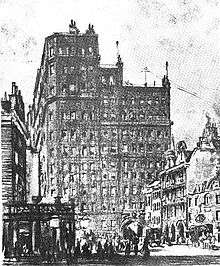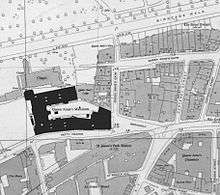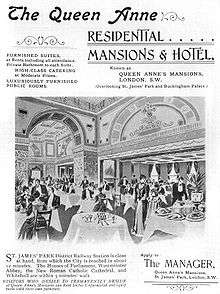Queen Anne's Mansions


Queen Anne's Mansions was a block of flats in Petty France, Westminster, London at grid reference TQ296795.[1] In 1873, Henry Alers Hankey acquired a site between St. James's Park and St. James Park Station. Acting as his own architect, and employing his own labour, he proceeded to erect the first stage of the block. At twelve stories, later increased to fourteen, it was the loftiest residential building in Britain.
The Court Circular for January, 1897 describes them as "a stupendous pile which, for solidity, comfort and general convenience, sets all rivals at defiance, although twenty years have elapsed and imitations have been legion"[2]
History
Hankey further extended the flats in 1874 and 1877 to the south and west. There were objections to the height of the flats, not least from Queen Victoria who could no longer view the Houses of Parliament from Buckingham Palace. But because existing legislation did not explicitly prohibit building over 100 ft the authorities could not stop Hankey. However, the London Building Act passed in 1894, and its 80-ft height limit, was a direct result of "Hankey's Mansions".

It may have been legal complications that led him, for the remainder of the work, to employ an architect, E. R. Robson. Robson continued the mansions around the central courtyard, leaving only Queen Anne's Lodge as the sole survivor of the residential properties that had formerly stood on the site. Just before the turn of the century, however, Hankey ran into financial difficulties and the property passed into the hands of the Official Receiver. Under new management, the west block became a hotel and the remainder was let as flats and service suites.
During the Second World War, the entire building was requisitioned as Government offices, and it was decided to construct a shelter. A long room in the west block, originally a theatre, had supporting piers built up from the foundation, and a stout reinforced concrete slab was laid to give head cover. This was a wise decision as two direct bomb-hits caused debris to overload the upper floors, causing a vertical gash through the entire building.
Queen Anne's Mansions was home to the Medical Department of the Royal Navy (Admiralty) during WW2.[3]
In 1947, the Ministry of Works retained the building on a 21-year lease.
In 1973, Queen Anne's Mansions were demolished and later replaced by 50 Queen Anne's Gate.
Facilities
A typical unit of accommodation was a living room, about 23 ft by 14 ft, a bedroom and a bathroom. In the corner blocks were some more commodious suites. Notwithstanding the prejudice against the building, no difficulty was found in letting the flats at high rents to tenants of the 'highest respectability'. A floor containing six rooms, without any grounds, commanded £300 per annum, and two rooms £60 per annum.[4] The principal novelty of the building was the installation of hydraulic passenger lifts, at that time without precedent in domestic buildings in London. Fire control was also provided for by 98 hydrants, supplied from tanks storing 70,000 gallons on the roofs.
Famous residents
- Edward Elgar (composer) "Elgar took a London flat in Queen Anne's Mansions so as to be able to concentrate on the concerto"[5]
- Augusta, Lady Gregory (Irish dramatist and folklorist) "AG had given up her rooms in Queen Anne's Mansions before leaving for Italy on 17 Mar," ... "she leased new rooms in Queen's Anne's Mansions at the beginning of 1902"[6]
- Sir Harry Johnston (British explorer) "Arrived in London toward the end of June, 1888, I established myself at Queen Anne's Mansions, in a small but comfortable flat on the sixth floor"[7]
- Eliza Lynn Linton (British novelist, essayist, and journalist) [8]
- Dr. Frederick Quin (homeopathy was first established in Britain, by) "Quin died of bronchitis at the Garden Mansions, Queen Anne's Gate, Westminster, on 24 November 1878"[9]
- Sir John Fowler (Civil Engineer) who had lodgings on the site prior to the building of the mansions. "Sir John Fowler retained in the reconstructed buildings an office which is still known as 2, Queen Square Place. There is no number one, nor any other house in the 'Place'". Fowler's insistence in keeping his old address confused many of his clients, who would regularly end up in other parts of London. His working partner, Sir Benjamin Baker, tried in vain to get him to accept the change of address but "asked his partner to yield to the foible of an old man." [10]
See also
- Nelson-class battleships; the high slab-sided superstructure of HMS Nelson and Rodney being compared to 'Queen Anne's Mansions'.
References
- ↑ Hamilton et al. National Building Studies, special report 33, pages 143-150. Published HMSO, London 1964
- ↑ Quoted in "Queen Anne's Mansions: the story of 'Hankey's Folly'" by S. E. Manqeot. Architect & Building News, 1939 Jan. 13, page 77-79
- ↑ "http://journals.cambridge.org/action/displayFulltext?type=1&fid=778588&jid=PNS&volumeId=12&issueId=03&aid=778580
- ↑ "Queen Anne's Mansions and Milton's Garden", The Builder, June 2, 1877 page 556
- ↑ page 119, "The Life of Elgar" by Michael Kennedy. pub. 2004 C.U.P
- ↑ page 60, "The Collected Letters of W.B. Yeats" by Yeats et al., Pub. 2005 O.U.P
- ↑ page 119, "The Life and Letters of Sir Harry Johnston" By Alex Johnston. Pub. 2005 Kessinger Publishing
- ↑ page 193, "The Late-Victorian Marriage Question: A Collection of Key New Woman Texts" by Ann Heilmann. Pub. Routledge 1998.
- ↑ page 693, "Oxford Dictionary of National Biography", Pub. 2004 O.U.P
- ↑ page 118, "The Life of Sir John Fowler, Engineer" By Thomas McKay. Pub 1900 John Murray, Albemarle Street
Further reading
- English Heritage viewfinder website (Has 4 photographs of the interiors, taken 1893 to 1898...search for "Queen Annes Mansions"...accessed 30-March-2008)
- Dennis, Richard (November 2008). "'Babylonian Flats' in Victorian and Edwardian London" (PDF). The London Journal. 33 (3): 233–247. doi:10.1179/174963208x347709.
Coordinates: 51°29′59″N 0°08′03″W / 51.49959°N 0.13430°W